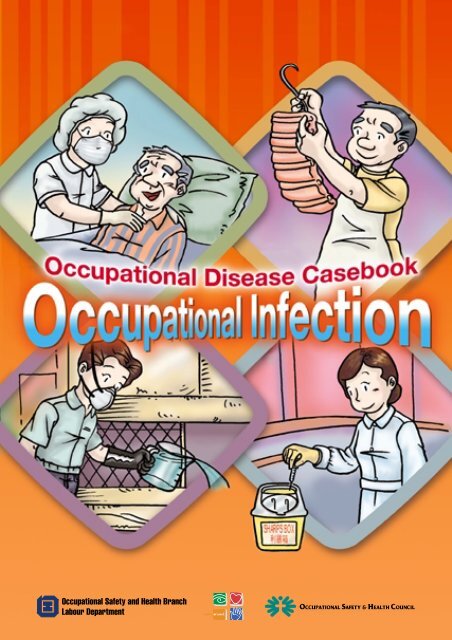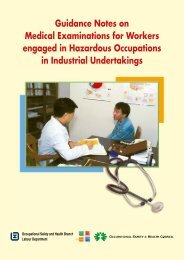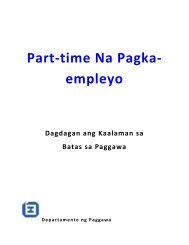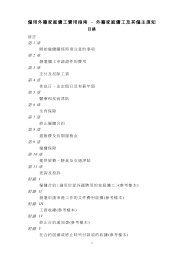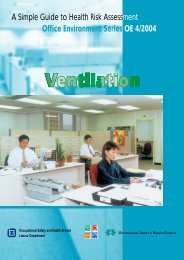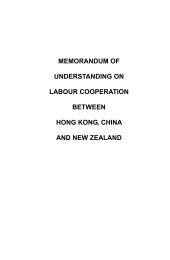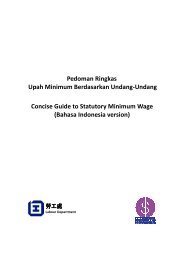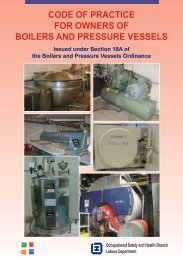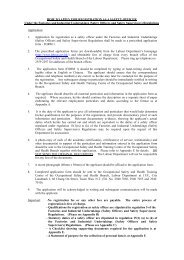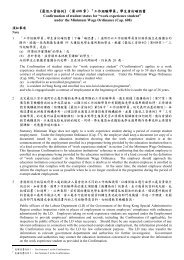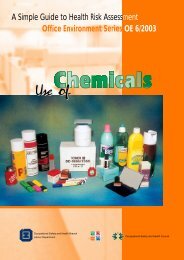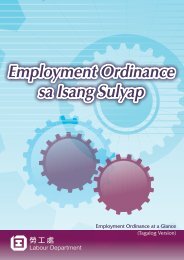Occupational Infection
Occupational Infection
Occupational Infection
Create successful ePaper yourself
Turn your PDF publications into a flip-book with our unique Google optimized e-Paper software.
This booklet is prepared by the<br />
<strong>Occupational</strong> Safety and Health Branch,<br />
Labour Department<br />
This Edition January 2006<br />
This booklet is issued free of charge and can be obtained from offices of the<br />
<strong>Occupational</strong> Safety and Health Branch of Labour Department or downloaded<br />
from the Labour Department's website at http://www.labour.gov.hk/eng/public/<br />
oh/OHB95.pdf. Addresses and enquiry telephone numbers of the offices can<br />
be found by calling 2559 2297 or visiting the Labour Department's website at<br />
http://www.labour.gov.hk/eng/tele/osh.htm.<br />
This booklet may be freely reproduced except for advertising, endorsement or<br />
commercial purposes. Please acknowledge the source as "<strong>Occupational</strong> Disease<br />
Casebook - <strong>Occupational</strong> <strong>Infection</strong>" published by the Labour Department.
Contents<br />
Introduction 1<br />
Case 1: Tuberculosis 2<br />
Case 2: <strong>Infection</strong> by Streptococcus suis 5<br />
Case 3: Legionnaires' Disease 8<br />
Case 4: Parenterally Contracted Viral Hepatitis 12<br />
Conclusion 15<br />
Enquiry Service 17
<strong>Occupational</strong> Disease Casebook -<strong>Occupational</strong> <strong>Infection</strong><br />
Introduction<br />
<strong>Occupational</strong> hazards can generally be divided into three main<br />
categories:<br />
Physical hazards<br />
: for example, high temperature, high barometric pressure,<br />
etc.<br />
Chemical hazards : for example, some heavy metals and their compounds,<br />
organic solvents, etc.<br />
Biological hazards : for example, bacteria, virus, fungus, etc.<br />
<strong>Occupational</strong> hazards vary from industry to industry. As far as biological hazards<br />
are concerned, industries at risk include health care services, agriculture and livestock<br />
keeping industries, slaughtering, transportation of livestock and manufacturing<br />
and processing of animal and plant products. Precautions should also be taken<br />
against these hazards for work involving frequent contact with and the handling of<br />
contaminants and waste, such as cleaning, drainage and repairs.<br />
Micro-organisms can enter the body through different routes like inhalation, contact<br />
with skin (especially damaged skin) or mucous membrane. If workers do not take<br />
appropriate precautions at work, they may get infected.<br />
The objective of this booklet is to illustrate, through case studies, the causes of<br />
occupational infections, and to advise on specific preventive measures.<br />
1
Case 1<br />
Tuberculosis<br />
Case Summary<br />
Margaret had been working as a health care worker at an elderly home<br />
for three years. Her daily job was to provide personal care service for the<br />
residents, such as assisting them in eating and cleaning, tidying beds,<br />
giving medicines and cleaning wounds. About three months ago, Margaret<br />
began to cough persistently with blood-stained sputum. She also had<br />
drastic weight loss and frequent night sweating. She<br />
sought treatment at a chest clinic. The X-rays<br />
showed opacities in her lungs. Mycobacterium<br />
tuberculosis was identified in her sputum.<br />
The doctor diagnosed that she had<br />
pulmonary tuberculosis.<br />
2
<strong>Occupational</strong> Disease Casebook - <strong>Occupational</strong> <strong>Infection</strong><br />
Causes of the Illness<br />
According to the doctor's analysis, Margaret contracted pulmonary tuberculosis<br />
for the following reasons:<br />
1<br />
2<br />
3<br />
Three months before the onset of the disease, Margaret was taking<br />
care of a resident who had been coughing for weeks. The resident<br />
was not given immediate medical treatment as his condition was not<br />
serious at the early stage. He was arranged to see a doctor after a<br />
few weeks when he coughed up blood. He was diagnosed as having<br />
pulmonary tuberculosis and hospitalized.<br />
During the resident's stay at the elderly home, droplets containing the<br />
bacteria might disperse in the air whenever he coughed and sneezed.<br />
As Margaret had not worn a suitable mask when taking care of him,<br />
she might have inhaled the infective droplets.<br />
Poor ventilation at the elderly home resulted in accumulation of the<br />
bacteria in the air.<br />
3
Case 1 Tuberculosis<br />
Preventive Measures<br />
The following measures can help to prevent contracting pulmonary tuberculosis<br />
at an elderly home:<br />
1<br />
2<br />
3<br />
4<br />
5<br />
Keep the workplace clean and well-ventilated.<br />
Staff could put on surgical masks while at work.<br />
Residents and staff with symptoms of respiratory tract infection (such<br />
as coughing and sneezing) should put on surgical masks whenever<br />
possible. Otherwise, they should cover their noses and mouths with<br />
tissue paper when coughing or sneezing. Do not spit. Wash hands<br />
frequently.<br />
If a resident or a staff member is suspected to have<br />
contracted pulmonary tuberculosis with symptoms<br />
such as coughing with or without blood, fever and<br />
drastic weight loss, he or she should seek medical<br />
treatment as soon as possible.<br />
Keep a healthy lifestyle to strengthen body<br />
immunity, such as taking a balanced diet, having<br />
adequate exercise and rest, staying happy,<br />
refraining from smoking and drinking, and<br />
keeping good personal hygiene.<br />
4
Case 2<br />
<strong>Infection</strong> by<br />
Streptococcus suis<br />
Case Summary<br />
Simon was employed in a meat stall in the wet market. His daily job was to<br />
cut up butcher meat and hang it in the stall for sale. One day, he accidentally<br />
injured his finger while chopping the pork, but he paid no heed to the wound<br />
and continued to work. He did not treat his wound until after work. On the<br />
third day, he began to have symptoms like headache, cough, tiredness,<br />
blocked nose, etc. Later on, he also developed fever, neck rigidity, neck<br />
pain and dizziness. He was admitted to the hospital and diagnosed<br />
as having Streptococcus suis meningitis. Although his life<br />
was not in danger after treatment, he had sensorineural<br />
hearing loss as a complication.<br />
5
Case 2<br />
<strong>Infection</strong> by Streptococcus suis<br />
Causes of the Illness<br />
Simon contracted Streptococcus suis meningitis for the following reasons:<br />
1<br />
2<br />
He was unaware of the possible existence of Streptococcus suis<br />
in raw pork and did not take any precaution.<br />
He did not take immediate treatment to his wound which was<br />
subsequently infected.<br />
AHH !<br />
AHH !<br />
6
<strong>Occupational</strong> Disease Casebook - <strong>Occupational</strong> <strong>Infection</strong><br />
Preventive Measures<br />
The following measures can be taken to prevent infection by Streptococcus<br />
suis:<br />
1<br />
2<br />
3<br />
Wear cut-proof gloves when chopping the pork to prevent the hands<br />
from being injured.<br />
Clean and bandage the wound immediately and properly to prevent<br />
infection.<br />
Pay attention to personal hygiene and keep both hands clean.<br />
7
Case 3<br />
Legionnaires' Disease<br />
Case Summary<br />
Mike was a technician responsible for the repair and maintenance of fresh<br />
water cooling towers of air-conditioning systems. About a week ago, he<br />
suddenly developed high fever, chest pain, cough and difficulty in breathing,<br />
etc. Later on, he became confused and was hospitalized. His chest X-ray<br />
showed signs of pneumonia and other investigations confirmed the diagnosis<br />
of Legionnaires' disease.<br />
8
<strong>Occupational</strong> Disease Casebook - <strong>Occupational</strong> <strong>Infection</strong><br />
Causes of the Illness<br />
Mike contracted Legionnaires' disease for the following reasons:<br />
1<br />
2<br />
3<br />
Three days before the onset of the disease, he had repaired a<br />
malfunctioned fresh water cooling tower in a commercial building.<br />
As the cooling tower was not cleaned and disinfected regularly,<br />
the bacteria, Legionella pneumophila proliferated in the tower and<br />
tiny water droplets and aerosols containing the bacteria were<br />
dispersed into the air.<br />
He had no knowledge about Legionnaires' disease, and did not<br />
know that the disease could be transmitted through inhalation of<br />
contaminated water droplets or aerosols. Therefore, he did not<br />
take any precaution.<br />
He was a smoker, and tobacco smoke made him more susceptible<br />
to infection.<br />
9
Case 3<br />
Legionnaires' Disease<br />
Preventive Measures<br />
The following measures can be adopted to prevent cooling tower maintenance<br />
technicians from contracting Legionnaires' disease:<br />
1<br />
Clean and disinfect fresh water cooling towers regularly with bactericide<br />
to prevent the proliferation of the bacteria.<br />
Disinfectant<br />
10
<strong>Occupational</strong> Disease Casebook - <strong>Occupational</strong> <strong>Infection</strong><br />
2<br />
3<br />
4<br />
Install aerosol elimination devices in cooling towers to minimize the<br />
transmission of the bacteria through aerosol.<br />
Use appropriate respirators (e.g. N-95 mask) to avoid inhalation of<br />
contaminated aerosol while carrying out the maintenance work<br />
involving cooling towers.<br />
Maintain a healthy lifestyle, particularly the avoidance of smoking, to<br />
strengthen body immunity and reduce the risk of infection.<br />
11
Case 4<br />
Parenterally Contracted<br />
Viral Hepatitis<br />
Case Summary<br />
Lily had been working as a nurse in a private clinic for more than three<br />
years. She was responsible for assisting the doctor in the caring of wounds<br />
and giving injection. About two months ago, she developed fatigue, anorexia,<br />
abdominal discomfort, nausea and vomiting, etc. Later, her skin and the<br />
sclera (the white of her eyes) gradually turned yellow. She was admitted to<br />
the hospital for treatment. After a series of examinations, she was diagnosed<br />
to have acute hepatitis B.<br />
12
<strong>Occupational</strong> Disease Casebook - <strong>Occupational</strong> <strong>Infection</strong><br />
Causes of the Illness<br />
According to the doctor's investigation, Lily contracted acute hepatitis B<br />
because of the following reasons:<br />
1<br />
2<br />
3<br />
Two months before the onset of the disease, she gave an injection<br />
to a hepatitis B carrier. She punctured her left thumb accidentally<br />
when re-capping the needle after the injection.<br />
She had not been vaccinated against hepatitis B.<br />
She only covered her wound with dressing. She neither reported the<br />
accident to her supervisor nor sought proper medical treatment<br />
immediately.<br />
Preventive Measures<br />
To avoid contracting hepatitis B as Lily's case, the following measures can<br />
be adopted:<br />
1<br />
Undergo a pre-employment medical examination if there are<br />
possible exposures to blood or other body fluids at work.<br />
Vaccination against hepatitis B should be taken if the examination<br />
result is negative for hepatitis B antibodies. About 90 to 95% of<br />
people would have long-term immunity against the disease after<br />
a course of three injections.<br />
13
Case 4<br />
Parenterally Contracted Viral Hepatitis<br />
2<br />
Handle instruments contaminated with blood or other body fluids<br />
carefully. Do not attempt to re-cap the needle. Dispose the used needle<br />
into sharps box immediately.<br />
3<br />
In the case of accidental injury by contaminated instruments, inform<br />
the employer or supervisor and consult doctors for suitable medical<br />
treatment.<br />
SHARPS BOX<br />
= =<br />
DANGER<br />
14
Conclusion<br />
Although this booklet only presented four cases of occupational infection from<br />
different industries, the causes involved and the respective preventive measures<br />
are also useful to employers and employees of other trades.<br />
In fact, the prevention of occupational infection is mainly based on the following<br />
principles:<br />
1<br />
Keep the workplace clean and hygienic, and eliminate or control the<br />
sources of infection to reduce the risk of disease spread.<br />
2<br />
If anyone in the workplace has symptoms of infectious diseases<br />
(e.g. pulmonary tuberculosis), he or she should seek medical treatment<br />
as soon as possible to reduce the risk of transmission.<br />
3<br />
Ensure adequate ventilation in the workplaces.<br />
4<br />
Adopt preventive measures and use personal protective equipment<br />
(PPE) that are appropriate for the work nature. In addition, PPE should<br />
be properly maintained and promptly replaced if they have defects.<br />
5<br />
If there is a wound, clean and dress it quickly to avoid infection.<br />
15
Conclusion<br />
6<br />
Vaccinations can prevent certain infectious diseases (e.g. hepatitis B).<br />
Employees who are not immune to these infectious diseases should<br />
be vaccinated if vacinations are available.<br />
7<br />
Maintain a healthy lifestyle to strengthen body immunity and reduce<br />
the risk of infection.<br />
Employers and employees can take appropriate preventive measures in<br />
accordance with the above principles to minimize the risk of contracting infections.<br />
16
Enquiry Service<br />
For enquiries on this booklet or advice on occupational health and hygiene<br />
matters, please contact the <strong>Occupational</strong> Safety and Health Branch of the Labour<br />
Department through:<br />
Telephone 2852 4041<br />
Fax 2581 2049<br />
E-mail<br />
enquiry@labour.gov.hk<br />
Information on the services offered by the Labour Department and on<br />
major labour legislation can also be found by visiting our website at<br />
http://www.labour.gov.hk.<br />
Information on the services provided by the <strong>Occupational</strong> Safety and Health<br />
Council can be obtained through hotline 2739 9000.<br />
<strong>Occupational</strong> Safety and Health Compliant Hotline:<br />
If you have complaints about unsafe workplaces and practices, please call the<br />
Labour Department’s occupational safety and health complaint hotline at<br />
25422172.<br />
17
1/2006-1-OHB95a


